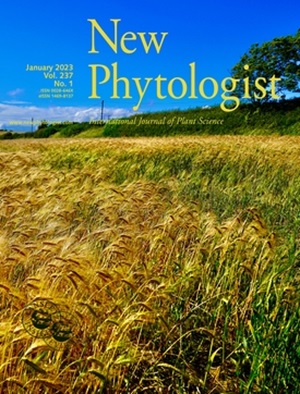E3泛素连接酶BRG3和蛋白激酶MPK7拮抗调节苹果中硝酸盐和赤霉素信号整合的关键节点LBD36的转换
IF 8.3
1区 生物学
Q1 PLANT SCIENCES
引用次数: 0
摘要
硝酸盐是植物体内氮的主要来源。硝酸盐刺激引起植物次生代谢产物的变化,包括花青素。然而,硝酸盐调控花青素生物合成的分子机制尚不清楚。本研究在苹果中鉴定了一个硝酸盐响应因子MdLBD36。该因子通过促进花青素重要调控因子MdABI5的转录活性,正向调节硝酸盐缺乏诱导的花青素生物合成,并直接激活MdABI5的表达。E3泛素连接酶MdBRG3促进MdLBD36的泛素化降解,减少硝酸盐充足条件下花青素的生物合成。硝酸盐缺乏激活的MdMPK7通过抵消mdbrg3介导的MdLBD36的降解,维持了MdLBD36对花青素生物合成的刺激作用。硝酸盐协调赤霉素(GA)信号调控花青素的生物合成。GA信号抑制因子MdRGL2a通过增强MdLBD36- MdABI5的相互作用和增加MdLBD36对MdABI5的转录激活,促进MdLBD36促进花青素的生物合成。总之,我们的研究结果阐明了通过泛素化和磷酸化协调调节硝酸盐信号反应和花青素生物合成的分子框架。本研究揭示了硝酸盐与GA信号在花青素生物合成调控中的串扰,为深入探索硝酸盐信号转导通路及其与激素的相互作用提供参考。本文章由计算机程序翻译,如有差异,请以英文原文为准。
The E3 ubiquitin ligase BRG3 and the protein kinase MPK7 antagonistically regulate LBD36 turnover, a key node for integrating nitrate and gibberellin signaling in apple
- Nitrate is the main source of nitrogen in plants. Nitrate stimulation causes changes in plant secondary metabolites, including anthocyanins. However, the molecular mechanism underlying how nitrate regulates anthocyanin biosynthesis remains unclear. In this study, we identified a nitrate response factor MdLBD36 in apple. This factor positively regulated nitrate deficiency-induced anthocyanin biosynthesis by promoting the transcriptional activity of MdABI5, an important regulator of anthocyanins, and directly activated MdABI5 expression.
- The E3 ubiquitin ligase MdBRG3 promoted the ubiquitinated degradation of MdLBD36 to reduce anthocyanin biosynthesis under nitrate-sufficient conditions. Nitrate deficiency-activated MdMPK7 maintained the stimulating effect of MdLBD36 on anthocyanin biosynthesis by counteracting the MdBRG3-mediated degradation of MdLBD36.
- Nitrate coordinated gibberellin (GA) signaling to regulate anthocyanin biosynthesis. The GA signaling repressor MdRGL2a contributed to MdLBD36-promoted anthocyanin biosynthesis by enhancing the MdLBD36–MdABI5 interaction and increasing the MdLBD36 transcriptional activation of MdABI5.
- In summary, our results elucidate the molecular framework of the coordinated regulation of the nitrate signaling response and anthocyanin biosynthesis by ubiquitination and phosphorylation. This study revealed the cross talk between nitrate and GA signaling in the regulation of anthocyanin biosynthesis and provides references for an in-depth exploration of the nitrate signal transduction pathway and its interactions with hormones.
求助全文
通过发布文献求助,成功后即可免费获取论文全文。
去求助
来源期刊

New Phytologist
生物-植物科学
自引率
5.30%
发文量
728
期刊介绍:
New Phytologist is an international electronic journal published 24 times a year. It is owned by the New Phytologist Foundation, a non-profit-making charitable organization dedicated to promoting plant science. The journal publishes excellent, novel, rigorous, and timely research and scholarship in plant science and its applications. The articles cover topics in five sections: Physiology & Development, Environment, Interaction, Evolution, and Transformative Plant Biotechnology. These sections encompass intracellular processes, global environmental change, and encourage cross-disciplinary approaches. The journal recognizes the use of techniques from molecular and cell biology, functional genomics, modeling, and system-based approaches in plant science. Abstracting and Indexing Information for New Phytologist includes Academic Search, AgBiotech News & Information, Agroforestry Abstracts, Biochemistry & Biophysics Citation Index, Botanical Pesticides, CAB Abstracts®, Environment Index, Global Health, and Plant Breeding Abstracts, and others.
 求助内容:
求助内容: 应助结果提醒方式:
应助结果提醒方式:


